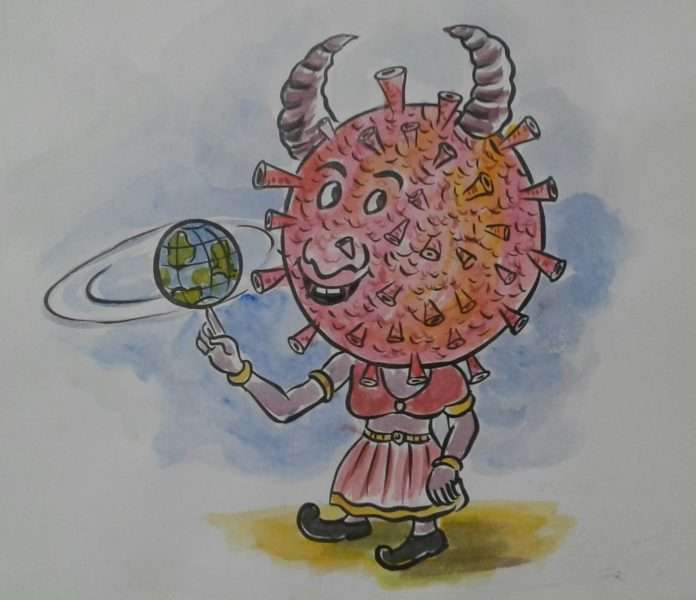Impact of virus and bacteria on human civilization is ancient. Though the first impact is not
clearly established, the major prehistoric epidemic, circa in ~3000 BC in China, is revealed
by “Hamin Mangha archeological sites”. Subsequently, plague has been the greatest
epidemic, the greatest of them include Athen’s plague in 430 BC, Antoine plague during 165-
180 AD that killed 5 million people in the Roman empire, Cyprian plague (250-271 AD),
Justinian plague (541-542 AD), American plague (1500s AD), Great plague of London (
1665-1666 AD), Great plague of Marseille (1720-1723 AD), Russian plague (1770-1772 AD)
etc.
Other major epidemic comprises black death in 1346-1353 caused by a bacterium strain of
Yersinia pestis that travelled from Asia to Europe and killed roughly half the population of
Europe at that point of time. Fortunately, this does not exist anymore. Salmonella paratyphi
C caused Cocoliztli epidemic in 1545-1548 killing 15 million people in Mexico and Central
America. Few other major epidemic includes Philadelphia yellow fever epidemic in 1793, flu
pandemic in 1889-1890, American polio epidemic in 1916, Spanish flu in 1918-1920, Asian
flu in 1957-1958, AIDS since 1981 till today, H1N1 swine flu in 2009-2010, West African
ebola in 2014-2016, Zika virus in 2015 till now, and COVID-19 (a form of corona virus) in
2019 till now.
The difficulty in understanding such epidemic/pandemic diseases in ancient and medieval
time period was that the cause was invisible. Size of virus/bacteria that causes such epidemic
diseases are in less than micrometer (1 million of a meter) range. The best human eye can see
at best 100 micrometer (or 10 % of a millimeter). Rotavirus that is responsible for highly
contagious diarrhea has a size/diameter about 0.075 micrometer (75 nanometer). Similarly,
size/diameter of COVID-19 is about 0.125 micrometer (or 125 nanometer) making them
invisible to human naked eye. Moreover, these bacteria/viruses are highly contagious through
air, water, saliva, blood, etc. In ancient and medieval period, it was difficult to realize their
existence, thus, it was difficult to control their outbreak which made common people to
largely depend on tribal, religious or spiritual beliefs without getting much success. Virus
born chickenpox, smallpox and measles diseases are still being worshipped sometime in
tribal and rural pockets in Odisha as well as India.
Mercifully, in late 1500s Dutch people started learning how to make lens and were able to
magnify object. Galileo Galilei was able to make a device using such lens that was known as
microscope. Subsequently, Dutch scientist Antony van Leeuwenhoek, known as father of
microbiologist, in 1670s did pioneering work in developing microscope to see single human
cell, bacteria, virus etc. This development tremendously helped human civilization to explore
existence of virus and bacteria, their behavior and visualize them in human blood, saliva, etc.
to understand impact on human health/diseases. Subsequently, many virus and bacteria born
human diseases were identified, diagnosed and their possible remedy were found.

Despite all these progress and developments, viruses are more complex system to handle.
They need a host cell, like human cell, animal cell, etc. to multiply and propagate. They also
keep changing their DNA through mutation while changing host. This makes more difficult
to completely control them. Most of the recent pandemic COVID-19 is related to a diverse
family of Corona viruses. In Latin, corona means “crown”. These viruses have a spiky
projection at their surface, which scientist call it as like “crown”. Corona viruses may have
many host including human, but many kinds of corona viruses are found in bats. In human
they affect respiratory system. SARS in 2003 and MERS in 2012 are other corona viruses
that broke out into human life. In fact, COVID-19 is very similar to SARS and sometimes
referred as SARS-CoV-2.
Societal impact of such pandemic/epidemic outbreak is huge. Past experience of
epidemic/pandemic on human life and economy has been catastrophic. For instance, Europe’s
history was completely altered by plague. In those time when many people died due to
plague, shortage of laborers and workers became prominent. Positive side of this was that it
increased the pay and quality of life for laborers and lack of cheap labor force made people to
innovate and bring new technology.
Currently, when COVID-19 broke out in China, initially it was thought it will be confined to
the regional level within China. But unlike medieval period, today technology has excelled,
and the world has become a highly inter-connected village. People are travelling all across
the world on hourly basis and technology has increased human contact through electronic or
other devices. Thus, any epidemic/pandemic is not limited to local/regional phenomena
unlike in ancient/medieval period. Although in post globalized world, SARS, HIV etc. had an
outbreak, but none of them really impacted in a global scale, the way COVID-19 has done in
past 100 years. In a short period of time COVID-19 travelled all the continents and all most
all the countries in the world impacting hugely on economy, finance, health and governance.
Even in most advanced and developed countries having best health services, their medical
facilities are failing to cope with the emerging situation.
On the other side COVID-19 outbreak has realized the world that how lack of industrial
activities can lead a pollution free life. NASA satellite images have proven that NOx
(nitrogen dioxide) level in the atmosphere of China and Los Angeles area has completely
subsidized after COVID-19 compared to January 2020. Similar thing is being noticed in
North Italy, Spain and UK. Himalayan peaks have become visible from Jalandhar during
lockdown in India after 30 years. Pollution in New York city has decreased 50% during
COVID-19. American buffalos are seen in New York city after more than 100 years. It is
being estimated that increase in carbon dioxide level may drop to the level of during World
War II. Global emission is expected to decrease remarkably. At the same time, it is being
speculated that there will be great job cuts, especially in technology and service-based
industries, in post COVID-19. This will largely impact society. It may be possible that people
may look back to the roots and may think local instead of global by giving emphasis on
locally produced goods, medicine and other items. Whether such things happen or not,
definitely in post COVID-19 world will be different in its approach towards environment,
economy, travel, business and governance.
(The views expressed are the writer’s own)

Professor Digambara Patra Department of Chemistry American University of Beirut , Lebanon You can reach him at Web: http://myprofile.aub.edu.lb/dp03

